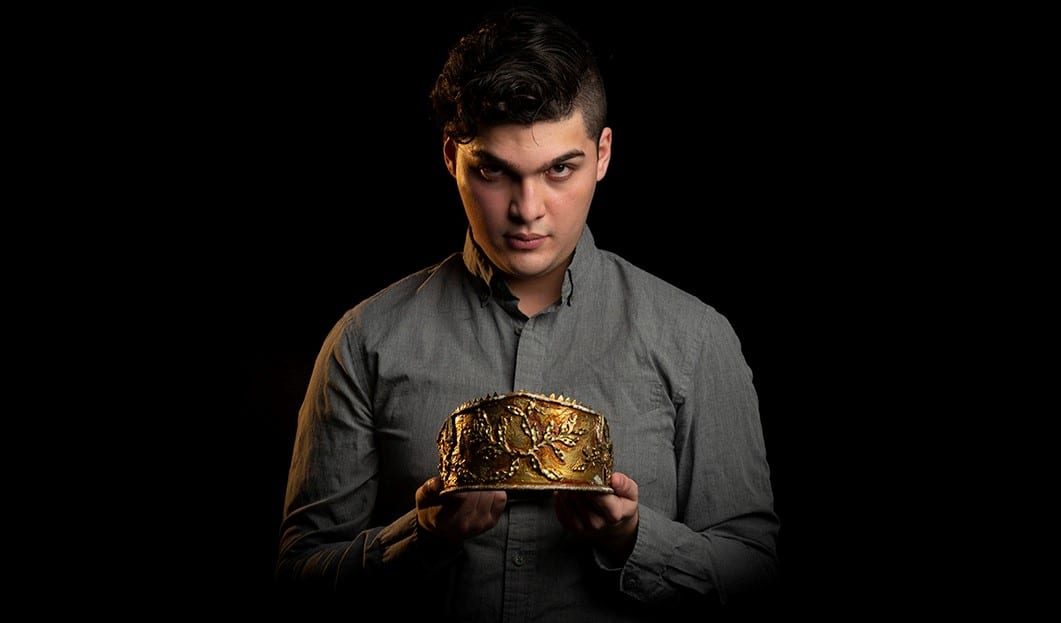SALT LAKE CITY — “The show must go in,” says producer Sydney Cheek-O’Donnell in a program note describing the University of Utah’s 2020-2021 season. And in it does go, in their livestreamed production of the classic Henry V. So far, the U. has done a great job with online theater. For one thing, they’ve added captions to the video, which is very helpful, both with understanding difficult Early Modern English, and as a tool to make their work accessible to disabled patrons.

When watching theater online, it is sometimes difficult to be enveloped in the world of the play, but with Stephanie Weeks’s direction and adaptation, the show embraces both the video medium and modern theatrical practices, with actors switching simple costume pieces on screen, breaking the fourth wall, and even acknowledging where other actors are on screen Brady Bunch-style. As the show program says, the action of the play takes place is here and there, and the time is now and then.
Sam Dalton’s scenic design takes the Zoom boxes and places them into and around gorgeous black and white sketches of maps and castle rooms that show where each scene is, allowing for some impressive scene changes with how the boxes and backgrounds move around. As for the actors’ rooms, they each have a nearly identical set that creates a classy look that does not distract. This works well with Meghan Gibson’s lighting design: simple colored lights that change to set the tone for each actor.
The props in the show (designed by Arika Schockmel) are fun; there are a lot of toys and items from around the house to represent what is happening in the story. (I did not know that I’ll see Cheeto Puffs fit so well into Shakespeare.) Ailish Harris’s sound design is hardly noticeable in the absolute best way possible. Elements like background water, campfire, and fighting in the background drew me into the scene and added a great depth to everything.

The Chorus and King Henry are played by all nine actors, who also play a few other characters each. This directorial choice is introduced beautifully by the actors trying to piece together Chorus’s prologue. The tone shifted so effortlessly from joking to serious that I got chills all the way down my spine. Weeks found such ingenious ways to bring the audience into 14th century England from Zoom. The show is so engaging and held my attention effortlessly.
That being said, I got the feeling throughout most of the show that if I was not already familiar with Henry V, I would have gotten rather lost in what was happening. All nine actors were fantastic and well trained. They all portrayed the personality of each character well, but they struggled with conveying the meaning in the language, and I often was not able to grasp what the characters really meant what they were saying. Throughout the performance, the actors recite well-rehearsed, though not necessarily well understood, poetry.
However, this is academic theater, and the goal is for students to learn how to do theater. Judging by that standard, Henry V is a lot better than most college Shakespeare. Weeks’s changes to the show make sense in this light. One helpful addition was that every time a new character appeared on stage, they announced themselves. This is something that would also be an appreciated addition to live stage productions of Shakespeare.

All nine King Henrys presented a different side of the king, which let the audience relate to the character in their own way. Among the talented cast, there were three that stood out as having more comprehension as to what their lines meant. Connor Nelis’s disguised Henry, walking through the soldiers’ camps, had deep characterization and a dynamic presence. Nelis’s monologue delivery was outstanding; it showed what Henry, as a character, was thinking—and was not just the actor trying to remember lines and notes. The best way to describe Lexie Thomsen’s portrayal of Henry is to quote dramaturg Ben Stanford’s program note: “Shakespeare contrasts power and humility in Henry.” Thomsen showed a thoughtfully intense warrior king, which added energy to the production. The final king was Jessica Graham, who played both Henry and Princess Katherine in the marriage proposal scene. This choice could have been distracting or gimmicky, until I saw how well she switched from a flirtatious Henry to a bold yet cautious Katherine. The scene was a beautiful blend of the actor’s ability and the director’s vision and guidance.
Shakespeare’s plays can be difficult to understand, and I should not dwell on that in any one staging too much. After all, this production of Henry V gave me the same feelings that live theater does. This particular version of the story ended up being more about the actors putting together a play than it was the actual plot of the story. But that is not necessarily a bad thing. The University of Utah’s production of Henry V was a welcome fresh take on Shakespeare, and superbly entertaining.
[box]The University of Utah Department of Theatre’s production of Henry V streams online Thursdays through Saturdays at 7:30 PM and Saturdays and Sundays at 2 PM through February 7. Tickets are $2-15 and free for high school students and University of Utah students. For more information, visit www.theatre.utah.edu.[/box]

